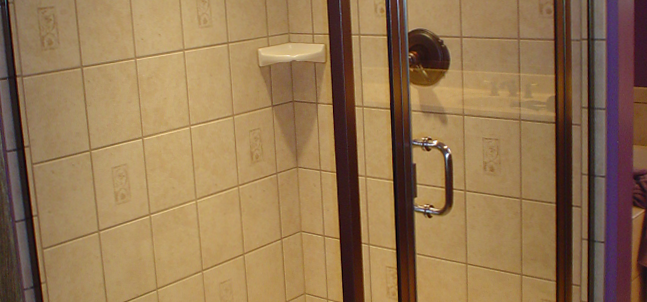Are Glass Shower Enclosures a Smart Choice?
Which Glass Doors Style?
Glass doors are modern. easy to clean, and important in resale of real estate.
When you are involved in improving your home or building a new home you probably face the decision of what shower enclosure to install.
In an instant, a frameless glass enclosure will give a more high–end effect.
An important factor when considering a glass shower enclosure is the choice of a swing door or a sliding door system. A sliding door is often used when there is a limited amount clearance. The door on a frameless enclosure can swing both 90 degrees in and 90 degrees out if so desired.
Amount of upkeep is normally in proportion to the amount of hardware used. When there is no frame (frameless) there is also no aluminum to oxidize and age.
When there is a fiberglass or acrylic surround then in a most cases it will requires a framed slider or swinging door.
When there is a custom shower or bath made of tile or solid surface material than a frameless.
ADVANTAGES of Glass Shower Doors:
• Modern feel
• Glass for easy cleaning
• Will add permanent home value
Please contact us for more info about shower enclosures.
Where Does Glass Come From?
The Origin and History of Glass
Glass was first made by man in the middle of the third millennium BC (2500 BC) in the land called in antiquity Mesopotamia. The land between the rivers of the Tigris and Euphrates, the area now known as Iraq and northern Syria.
The full potential of this material was not immediately realized and only small beads and other small objects were made by forming or casting.
It was not until sometime before 1500BC that the first glass vessels were made in Western Asia, and soon thereafter in the fifteenth century in Egypt. About this time, too, glass starts to be mentioned in the writing of Mesopotamia. The one of the earliest being a recipe written in Mesopotamia on a clay tablet dated between the fourteenth and twelfth centuries BC.
Due to the Roman political and economical unification of the Mediterranean that began in the middle of the first century BC the revolutionary technique of glass blowing was discovered in Syria and Palestine region.
The new technique made it possible to produce items more quickly and economically and for the first time glass was competitive with other less expensive materials.
Through the last two millenia glass has gone through several different ages of art, style, and development. In the late 17th century the process of creating lead crystal was discovered. In the 20th century blown glass and continuous pouring became mechanized and in 1959 the float glass furnace was developed and is how glass is still manufactured today.
Glass is made of three primary ingredients:
1. Silica (silicon dioxide), SIOz in the form of sand, which is called the former and is about 72% of the ingredients in glass.
2. Soda (sodium bicarbonate), NA2O. The soda acts as a flux and lowers the melting point of glass. About 16% of glass is soda.
3. Lime (calcium carbonate), C9O. The lime is the stabilizer
in glass and makes it strong and water and chemical resistant. Lime makes up about 8.2% of the material in glass.
Glass is a melted inorganic product that is cooled to a solid state without undergoing crystallization. The clustering of ions, atoms, and molecules is structured more like that of a liquid than a solid. Glass is considered to be a liquid because of it amorphous structure versus that of a crystalline which is a solid.

